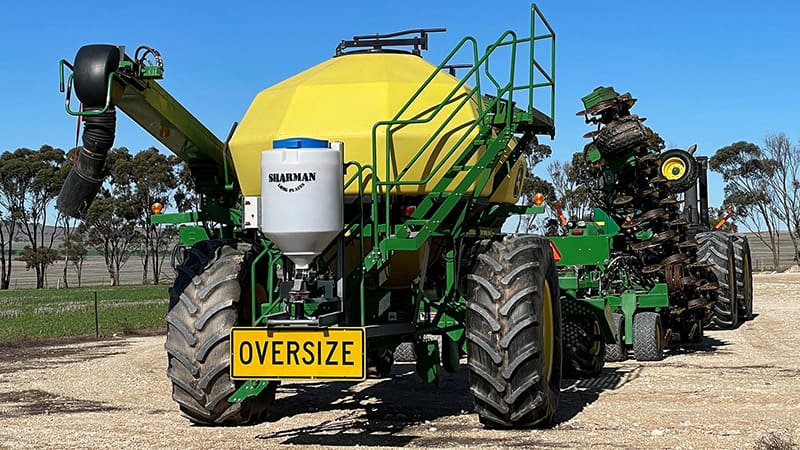
The project has developed a trial design and protocol to measure bait spreading distribution uniformity of at least two from each of the four types of ground application spreaders, and two aerial application methods. Photo: Ben White
A WESTERN Australia-based research project is under way to help Australian growers reduce crop losses due to mouse damage by optimising their bait-spreading operations.
Mouse populations across a large proportion of grain growing regions were higher than average across the 2021 and 2022 seasons, requiring an increased effort in mouse management from growers.
With Grains Research and Development Corporation investment, the Guidance for spreading mouse bait to improve efficacy and maintain bait integrity project is examining mouse bait-application techniques to better understand the performance and likely efficacy of various options.
The project team is coordinated by WA agricultural research engineer Ben White with technical and practical support from mechanical engineer Josh Giumelli and Victorian machinery specialist Mark Saunders.
Mr White said in regions where mice were a more frequent issue, grower awareness on bait spreading best practice was high, but in areas where mouse activity has not been as frequent, growers were not accustomed to spreading mouse bait.
“During periods of high mouse numbers – and with the imminent threat of crop losses – growers might access and use spreaders built for other purposes, such as mollusc bait and fertiliser spreaders,” Mr White said.
“As these spreaders are not set up correctly for applying mouse bait, growers have encountered issues such as scraping of active ingredients from the surface of the grain, blocking of apertures, and difficulty spreading at label rates and achieving the required bait coverage.”
Poor control through ineffective baiting operations increases the risk of crop losses caused by mice and the likelihood that additional bait applications may be required throughout the season, significantly impacting grower profitability.
Application methods examined
In consultation with researchers from CSIRO, including rodent expert Steve Henry, the project has developed a protocol to measure mouse bait spreading distribution uniformity of at least two from each of the four types of ground application spreaders, and two aerial application methods:
- 12v adjustable aperture metered spreaders;
- 12v roller metered spreaders;
- conventional linkage spreaders (PTO and hydraulic drive);
- modified metering door belt spreaders (trailing and linkage mounted);
- mixed wing aircraft; and
- unmanned Autonomous Vehicle (UAV).
The project will seek further input from researchers from Analytics for the Australian Grains Industry to analyse and quantify the uniformity of mouse bait distribution from each spreader.
If deemed appropriate, an effective Coefficient of Variance (CoV) will be established, or alternative measures to assess the uniformity of bait distribution in the context of bait spreading will be explored.
“A CoV for bait spreading serves as a tool to gauge how uniformly the bait is distributed within a swath,” Mr White said.
“It helps us understand how evenly or unevenly the product might be spread. In the case of ZnP (Zinc Phosphide), achieving an even distribution is essential to ensure optimal exposure for mice while also adhering to the legal requirement specified on the ZnP label with product rate.”
Additionally, the project has examined current grower practice through a consultative review, exploring grower, researcher and agronomist experiences with bait spreading options including spinner spreaders, small seed boxes, high velocity air and spreader plates; mounting options including air carts/seeding bars, 4WD vehicles, tractors, boomsprays and two-wheel motorbikes; and alterative spreading options including fixed wing, rotary wing (helicopters) and UAVs.
Improved information
GRDC crop protection manager west Georgia Megirian said the project results would provide growers across Australia with improved information and resources to optimise their bait spreading options during times of increased mouse pressure.
“This GRDC project will provide guidelines for different bait spreading equipment, and allow growers to hear directly from other growers, about what’s working for them, and what isn’t,” Ms Megirian said.
“A series of 15 case studies will explore the operation, equipment, methods, problems, solutions and relative efficacy growers have experienced, covering a range of spreader types and farming operations, and provide insights into growers’ decision-making process for spreading baits for mouse control.
“Mice pose a persistent challenge in broadacre cropping, with communities of grain growers across Australia highlighting their need for better insights into effective mouse management strategies, particularly when it comes to baiting efficiencies.
“This project is geared towards equipping Australian grain growers with the necessary resources and knowledge to do this.”
The GRDC project is underway throughout 2023, with results expected to be available for Australian grain growers from mid-2024.
Growers are encouraged to use GRDC’s Mouse Management resources to assist them in the lead up to harvest, including downloadable Mouse Chew Cards for monitoring.
They are also urged to report and map regional mouse activity using the MouseAlert website which assists in identifying mouse population ‘hot spots’ to facilitate timely management actions and help CSIRO’s rodent research team build a broader picture of mouse activity for the prediction of future outbreaks.
Source: GRDC

HAVE YOUR SAY